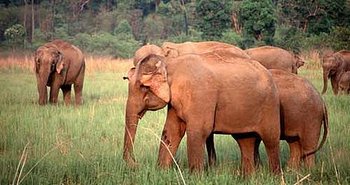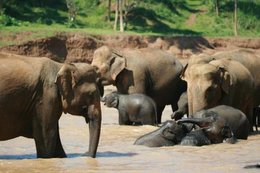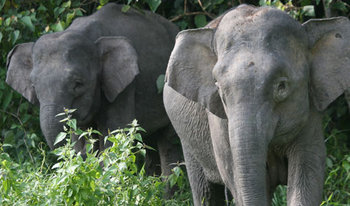Asian elephant
Contents
Introduction
One of the largest terrestrial mammals on Earth, the Asian elephant (Elephas maximus) belongs to the Elephantidae family. While this creature once roamed throughout much of the Asian continent, four subspecies currently exist as fragmented populations inhabiting portions ofBorneo (Elephas maximus borneensis), Sumatra (E. m. sumatranus), Sri Lanka (E. m. maximus), and southern Asia (E. m. indicus).In contrast to its African relative, the Asian elephant is slightly smaller; displays a less sloping back; has smaller, rounded ears; and its head region (rather than the shoulder area) constitutes the highest part of the body. This elephant also has a single finger-like projection on the upper lip of the trunk rather than the two projections found on its African cousin.Asian elephants are highly intelligent, long-lived mammals that may reach up to 60 years of age in the wild. They are also extremely sociable and occur in groups of related females that may sometimes join together to form herds, although these are more transient than those of African savanna elephants. Additionally, these mammals have had a close relationship with man over the centuries, serving as work animals and playing an important role in religious and cultural history. However, the continually growing human population of tropical Asia has encroached upon the elephant’s dense but dwindling forest habitat such that this mammal is now considered an endangered species. (Asian elephant)
Physical description
The Asian elephant is an enormous creature averaging 2.5 to 3.0 m (8.3 to 9.9 ft) in height and 5.5 to 6.4 m (18.2 to 21.1 ft) in length, with males being somewhat larger than females. Moreover, when full grown, an individual weighs between 2727 and 5000 kg (6,000 and 11,000 lbs). Such a stocky body is supported on stout, pillar-like legs, yet the feet consist of reduced phalanges resting on pads of elastic tissue that permit this gigantic mammal to walk very quietly. Skin covering is thick, dry, and essentially hairless, apart from a few sparse bristles. Skin color varies from dark grey to brown, although patches of pink may be visible on the forehead, ears, base of the trunk, and/or chest. The characteristic trunk is formed from elongation of the nose and upper lip, and it functions as a versatile tool for breathing, drinking, bathing, manipulating objects, and communicating. A limited number of very large teeth move forward in the animal’s mouth as it ages such that worn away front teeth are replaced from behind. However, if an elephant lives long enough to use up all of its teeth then it literally starves to death. In males, a pair of incisors may become elongated into tusks that grow an average of 17 cm (6.7 in) per year throughout the mammal’s lifetime. Interestingly, a significant number of adult males lack having tusks, and the percentage seems to vary by region (possibly reflecting the intensity of past ivory hunting), from only about 5% in Sri Lanka to 90% in southern India. Unlike African elephant females, Asian females possess only small tusks (or tushes) which seldom become distinguishable from their upper lips. Other noteworthy features of this species include having well-developed senses of hearing, smell, and touch. Additionally, constant flapping motion of the ears affords a rather effective means of dissipating body heat for this huge creature.
Subtle dissimilarities between the four subspecies help to distinguish one from the other. For example, Borneo pygmy elephants are the smallest of the Asian elephants, with males averaging 2.5 m (8.2 ft) in height. These individuals are also more rotund and possess rounder faces, larger ears, and longer tails that almost reach the ground. On the other hand, the Sri Lankan elephant is the largest and darkest of the subspecies, lacking colored skin patches on its ears, face, trunk, and belly.
Distribution
|
Conservation Status |
|
Kingdom: Animalia |
Centuries ago Asian elephants were widely distributed throughout Southeast Asia and in China as far north as the Yangtze River. Currently, there are only an estimated 28,000 to 42,000 wild Asian elephants remaining in dwindling forested regions of Bangladesh, Bhutan, Borneo, Myanmar, Cambodia, southern China, India, Indonesia, Laos, Malaysia, Nepal, Sri Lanka, Thailand, and Vietnam. Furthermore, most of these elephant habitats occur within national parks and protected reserves, but these regions are often too small to completely accommodate viable populations, leading to human-elephant conflicts. Sometimes these mammals are kept as domestic laborers, while others have been successfully bred in captivity to a limited extent.
In their natural settings, male elephants usually occupy home ranges of about 15 km2 (5.8 mi2) while those of female herds approach 30 km2 (11.6 mi2) or more (during the dry season). However, expanding human encroachment has dramatically disrupted the mammal’s migratory routes, resulting in isolated populations. In effect, fewer than ten populations comprise more than 1000 individuals in a contiguous area, greatly decreasing this species likelihood for long-term survival.
Habitat
Asian elephants primarily occupy different types of tropical rainforesis although their habitats may include adjacent areas that are more open and grassy. They can also be situated in landscapes that afford a combination of marshes, grasses, low woody plants, and trees. These locales may be situated in lowlands or at cooler altitudes nearing 3030 m (10,000 ft).
Behavior and reproduction
Typically, female Asian elephants (or cows) form groups consisting of six or seven related adults and their young. Moreover, these groups may join together to form herds of about 40 adult females, led by the oldest individual (or matriarch) who coordinates movements in search of food and water. When more than one herd exists in a local area, the collection is referred to as a clan.
In contrast, male elephants leave their natal groups upon reaching sexual maturity at around six or seven years of age, after which time they are predominately solitary. When these males become about 20 years old they begin experiencing musth, an extreme state of arousal triggered by blood levels of testosterone that may increase twenty-fold. This heightened hormonal state, which lasts about three weeks, causes individuals to behave aggressively and wander widely in search of females. Musth secretions also increase male attractiveness to females and may prompt fighting for female breeding rights. Generally, only dominant males are temporarily associated with herds and have access to sexually receptive females.
Cows attain sexual maturity at around ten years of age, demonstrating an estrus cycle of about 22 days. While there is no seasonality in their reproductive cycle, females are only receptive to copulation on the first day of estrus. Usually, female elephants bear a single calf following a gestation period of 18 to 22 months, with an inter-birth interval averaging three to four years when habitats are of good quality. Moreover, females can remain fertile until they are nearly 55 to 60 years of age.
A newborn calf weighs approximately 100 kg (220 lbs) and can stand shortly after birth. The infant may nurse from its mother or from other lactating females for as long as 18 months, although it normally begins consuming varying amounts of grass after several months. Infants may also eat their mothers’ dung which contains nutrients as well as symbiotic bacteria that aid in the digestion of plant cellulose. Mothers offer parental care to their young for several years after weaning, and youngsters customarily travel with mothers or older sisters by holding on to their tails.
When a potential predator such as a lion or tiger threatens a calf, the adult females form a defensive circle with the young elephant in the middle. If need be, elephants will charge an aggressor and have been known to run over 48 km/hr (29.8 mi/hr). Additionally, when threatened, elephants have been observed running with their tails held upright, which may signal the presence of danger to other members of the herd.
Research investigations of wild and captive elephants have also revealed a host of activities involving tusks and trunks. For instance, adult males employ tusks when digging for water, removing bark from branches, maneuvering fallen objects, marking trees, resting their trunks, fighting, and performing various types of domestic labor. Moreover, elephants appear to be either left- or right-tusked, just as humans are left- or right-handed. Their trunks, which are formed by a combination of the elongated nose and upper lip, are also very useful. At the tip is a single, finger-like extension that is very sensitive and can be used for precise manipulation of objects. Trunks are also used in eating, drinking, smelling, breathing, touching, vocalizing, bathing (i.e., throwing dirt onto the back, possibly as a way of deterring insects), and fighting.
Communication
Scientific studies have revealed that Asian elephants often communicate with one another, making infrasonic noises that human ears cannot detect. Also, these mammals use touch and scent to convey information. For instance, a nervous or stressed individual may place the tip of its trunk in another elephant’s mouth, while musth secretions indicate sexual readiness of mature adult males.
Feeding habits
Adult Asian elephants normally consume around 150 kg (330 lbs) of vegetation per day, of which only about 44% is actually digested (with the aid of symbiotic intestinal bacteria). Grasses make up the mainstay of the herbivorous diet but bark, roots, leaves, tree stems, vines, and shrubs are also eaten. When elephants forage in areas near plantations they will readily feed on cultivated crops such as bananas, rice, and sugarcane.
An elephant eats long grass by grasping a handful with its trunk and putting the bundle into its mouth. To consume short grasses, an individual kicks up a pile of dirt with its feet and then sweeps the vegetation into its mouth using the tip of the trunk. Shrubs are eaten by breaking off twigs with the trunk and inserting them directly into the mouth. To eat the bark off larger branches, an elephant holds the branch with its trunk and rotates it while scraping off the bark with its teeth, similar to the way that people eat corn on the cob. Elephants also drink about 140 L of water each day which necessitates that they never stray too far from a water supply.
On a daily basis, most of an elephant’s time is spent eating or traveling from one food location to another. Foraging usually occurs in the morning, evening, and at night, while rest periods in shaded areas are taken during the hottest part of the day. Because of their large dietary requirement, Asian elephants do not feed for more than a few days in any given location nor do they exhibit any territoriality.
Threats and conservation status
The Asian elephant is protected from international trade by its listing on Appendix I of the Convention on International Trade in Endangered Species of Wild Fauna and Flora (CITES), but nevertheless, illegal poaching (i.e., for ivory tusks) and habitat exploitation remain serious problems. Continually growing human civilizations have encroached upon the elephant’s forest habitat such that nearly 20% of the world’s population now resides in or near the scattered home ranges of this terrestrial mammal. Fierce competition for living and agricultural space has resulted in human suffering (i.e. in India, up to 300 people are killed by elephants each year), a dramatic loss of forest cover, and severely reduced numbers of wild elephants. As people settle in areas that were once the sole domain of this creature, human-elephant conflicts become increasingly common. Since elephants require large areas for foraging, the loss of forest cover has driven these mammals to destroy many plantations and cultivated fields in order to acquire adequate sustenance. For example, a single elephant can devastate a small farmer’s crop holding in one feeding raid. This makes these mammals the frequent target of retaliatory killings, especially when people are (fatally) injured.
There has also been concern about the genetic effects of reduced numbers of male big tuskers. The danger arises when their numbers become sufficiently depleted and poachers seek to kill more immature males for their smaller tusks. The loss of tuskers results in skewed female sex ratios among populations which can lead to increased incidences of inbreeding, high juvenile mortality, and overall low reproductive success. Moreover, removing large tuskers reduces the probability that these long-lived males will mate and exchange genes with females of different sub-populations. Furthermore, habitat loss creates the strong likelihood that elephants groups become so fragmented that they can no longer follow ancient migratory routes or mix with other herds, both of which help to maintain genetic variability within the species.
The capture of wild elephants for domestic use has also contributed to the fragility of some populations. While India, Vietnam, and Burma have seriously sought to ban this practice in order to conserve their wild herds, a significant number of Asian elephants are still taken each year to support the timber and tourist industries or illegal wildlife trade. Unfortunately, the crude capture methods employed by individuals have led to a rather high animal mortality level.
Even where suitable forest habitat exists, poaching remains a threat to elephants in many areas. Despite the ban on international trade of ivory, there are still some thriving but unregulated domestic ivory markets in a number of countries which fuel an illegal international exchange. Although most of the ivory comes from poaching of African elephants, Asian elephants are also illegally hunted for their tusks as well as for their skin. In some countries, political unrest is disrupting anti-poaching campaigns.
Contemporary research
The World Wildlife Fund (WWF) has been supporting elephant conservation for over 40 years, beginning with survey work in Sri Lanka and India in the 1960s. In 1998, WWF created the Asian Rhino and Elephant Action Strategy (AREAS) to conserve remaining populations of these endangered mammals as well as their habitats. The overall philosophy of this endeavor maintains that conservation success will only be possible through a wide-ranging approach that encompasses the protection of isolated areas while addressing issues of land-use practices. While the cornerstone of AREAS work is the creation of habitat landscapes, its programs also combine cutting-edge conservation biology with trade monitoring, community development, socio-economic analysis, public awareness campaigns, and policy advocacy. One of the best examples of AREAS success can be observed in the Terai Arc landscape, which encompasses parts of western Nepal and eastern India Here, WWF and its partners are restoring degraded biological corridors so that elephants can access their migratory routes without disturbing human habitations. The long-term goal is to reconnect 12 protected areas and encourage community-based action to mitigate human-elephant conflict. Additionally, WWF supports biodiversity conservation, awareness-building, and the mitigation of elephant retaliation practices among local communities in the eastern Himalayan landscapes of North Bank and Kaziranga Karbi-Anglong along with the Nilgiris Eastern Ghats landscape in southern India.
In many Asian countries, WWF also partners with TRAFFIC (an international wildlife trade monitoring network) and IUCN (the World Conservation Union) to reduce the threat that illegal and illicit domestic ivory markets pose to wild elephants. For instance, TRAFFIC manages a global record of ivory seizures, called ETIS (Elephant Trade Information System) that helps to identify trade routes and countries of particular importance in the illegal trade.
At the borders of Laos, Cambodia, and Vietnam, WWF is training, equipping, and supporting local staff to patrol protected areas and assess elephant distribution and numbers. The focus for WWF in Laos is safeguarding elephants in protected areas and reducing human-elephant confrontations, while in Vietnam, WWF works in Cat Tien National Park on elephant conservation.
In February 1999, WWF began establishing a safe haven for one of the largest remaining populations of the Sumatran elephant in Riau Province. By conducting research on elephant behavior, and working with local communities, WWF intends to develop solutions that ensure adequate living space for both humans and this mammal. A major breakthrough was achieved in 2004 with the designation of Tesso Nilo National Park (a protected area in Riau) which represents one of the last forested regions large enough to sustain a viable population of endangered Sumatran elephants. However, this territory continues to experience severe pressure, as Sumatra has what is perhaps the world’s highest deforestation rate. Since 1985 the island has lost 48% of its forests, representing more than 29.6 million acres.
Until WWF began working in Borneo, there had been no organized ecological studies of the pygmy elephant. As their habitat shrinks, these animals are forced into more frequent confrontations with humans over land and food. In June and July 2005, AREAS and WWF Malaysia carried out a study, led by Dr. Christy Williams and Raymond Alfred, which successfully attached satellite collars to five pygmy elephants in different herds in the Malaysian state of Sabah, in order to learn more about the mammals and their habitat. Preliminary data has already provided insight into the movement of these elephants and their use of the forests in Sabah, and the information is being shared with Malaysian officials to help influence both public and private land-use decisions.
References and further reading
- Ciszek, D. (2008). Elephas maximus Linnaeus, 1758. Retrieved July 24, 2009
- Friends of the National Zoo. (2002). Asian elephants. Retrieved July 29, 2009.
- Honolulu Zoo. (2008). Indian elephant. Retrieved July 29, 2009.
- National Geographic. (2009). Asian elephant. Retrieved July 29, 2009.
- The Wild Ones Animal Index. Asian elephants. (2000). Retrieved July 29, 2009, from http:// www.thewildones.org/Animals/elephant.html
- World Wildlife Fund. (n.d.) Asian elephants. Retrieved July 24, 2009, from http://www.worldwildlife.org/species/finder/asianelephants/asianelephant.html




0 Comments